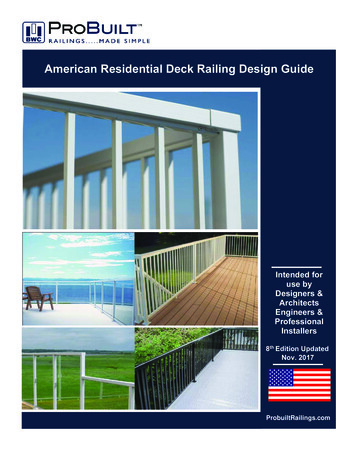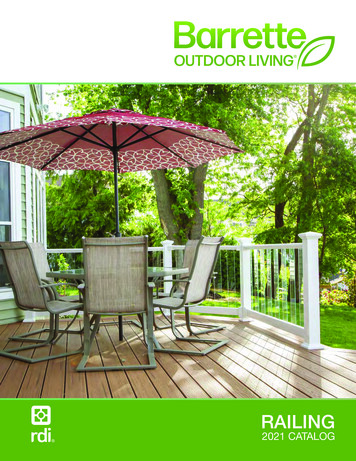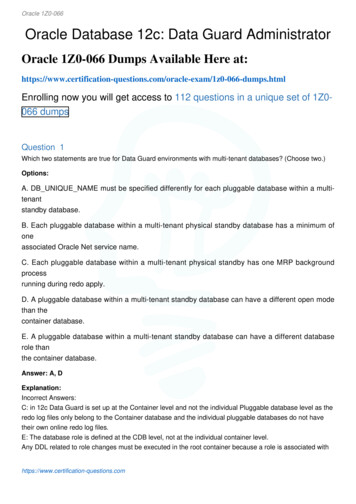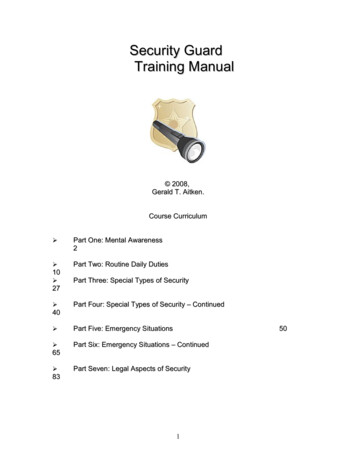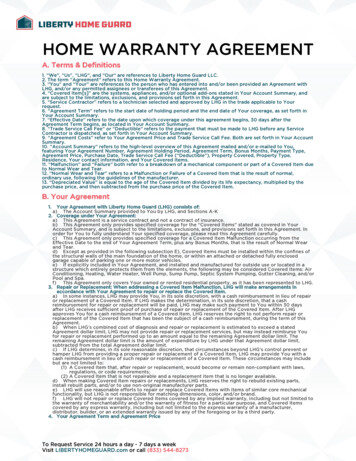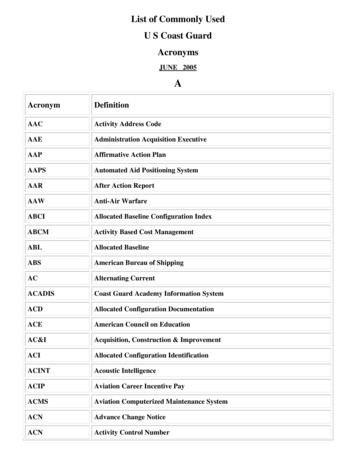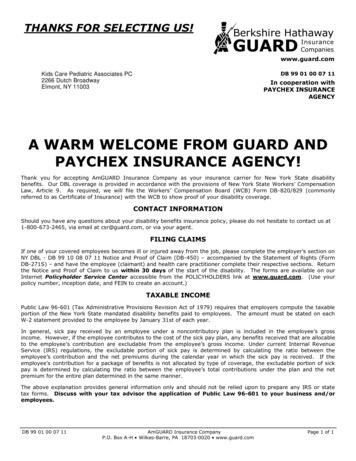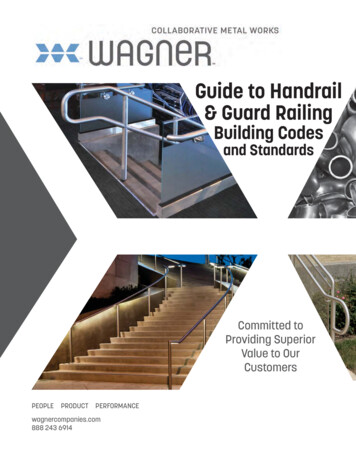
Transcription
Guide to Handrail& Guard RailingBuilding Codesand StandardsCommitted toProviding SuperiorValue to s.com888 243 6914
Table of ContentsHandrail and Guard Code IssuesIt is important to confirm all code issues with local authorities since many have not updated their requirements to currentlyavailable model codes. Prior to using any railing products, it is incumbent on designers, fabricators and installers to makethemselves familiar with local codes that apply to their applications. This document will provide information to guide you inyour understanding of the existing codes and standards and how they may applyA code comparison chart is included at the back of this document which provides key information relating to guard andhandrail listed in various codes.Table of ContentsCode Bodies and StandardsInternational Code Council (ICC)International Residential Code (IRC)International Building Code (IBC)National Fire Protection Association (NFPA)NFPA 101NFPA 5000Occupational Safety and Health Administration (OSHA) 2AccessibilityANSI-A117.1 Accessible and Usable Buildings and FacilitiesAmericans with Disabilities Act Standards for Accessible Design (ADASAD)Architectural Barriers Act (ABA)Handrail and GuardDefinitionsThe Ladder EffectLoad RequirementsGlass RailingCode Comparison ChartCopyright 2017, R & B Wagner, Inc.ISO 9001:2008F 414 214 0450 P 414 214 0444 T 888 243 69141135910
ICC and NFPAInternational Code Council (ICC )Most municipalities and local code bodies do not write code – they adopt model codesprepared by various code bodies.Historically, model codes were prepared by code bodies such as Building Officials CodeAdministrators International, Inc. (BOCA) – the National Building Code (NBC); SouthernBuilding Code Congress International (SBCCI) – the Southern Building Code (SBC); andthe International Conference of Building Officials (ICBO) – the Uniform Building Code(UBC).These various model building codes were adopted regionally by local authorities. Withmultiple code bodies, it was difficult to keep abreast of proposed changes by those notdirectly involved in the code process – e.g. architects, manufacturers and contractors.In 1999, BOCA, SBCCI and ICBO began to work together to prepare a unified code underthe auspices of the ICC.The first set of I Codes were published in 2000 and included the InternationalResidential Code (IRC) and the International Building Code (IBC). The IRC applies to oneand two-family dwellings while the IBC applies to commercial buildings and multi-familyresidential construction. The I Codes have since been adopted by states and municipalities throughout the country. Theyare published every three years – the most recent publication was in 2015.The I Codes are model codes. Local code authorities generally do not have the human resources to write their own codeso they adopt code using the model codes as the basis for their requirements. They may choose to adopt as is or makechanges as they deem appropriate. Your local jurisdiction may also be using an older of the I Codes.The I Codes provide minimum safeguards for people at home, at school and in the workplace. Based on your applicationa minimum standard may not be considered sufficient. The local authority having jurisdiction (AHJ) may reject yourinstallation if – in their opinion – your installation is unsafe.Always check with your local AHJ prior to proceeding with an installation.Anyone can submit a code change but be prepared for a multi-year process that will involve attending code hearings tojustify the requested change. Code books are available for purchase but you can view individual sections of the IBC andIRC on-line for free at www.iccsafe.orgNational Fire Protection Association (NFPA )The NFPA is a global organization devoted to eliminating death, injury, propertyand economic loss due to fire, electrical and related hazards. The associationdelivers information and knowledge through more than 300 consensus codesand standards.There are two NFPA documents which may apply to your application – NFPA5000: Building Construction and Safety Code and NFPA 101: Life Safety Code.NFPA 5000 was published in 2000 as an alternate to the I Codes. For the mostpart, it has not been adopted. However, provisions relating to handrail clearancethat are different from other codes and standards have been incorporated intoNFPA 101.NFPA 101: Life Safety Code provides requirements that limit the effects of fire andrelated hazards. It is most likely to apply to handrail along a fire exit or fire stairsbut is not applied in all instances (e.g. California does not use NFPA 101).The NFPA is overseen and enforced by local fire marshals – not the buildinginspector. An installation may be approved by an inspector but rejected by the fire inspector. Always confirmrequirements prior to installation. All NFPA codes may be viewed on-line for free at www.nfpa.org.wagnercompanies.com1
OSHAOccupational Safety and Health Administration (OSHA)OSHA is part of the United States Department of LaborPertinent section relating to handrails and guards is 1910.29Fall Protection Systems and Falling Object Protection –Criteria and Practices.These requirements primarily apply to areas not accessibleto the publicTOP RAILGuard Railing: 42 inches – plus or minus 3 inches above walking/workingsurface Required if the “drop” is 48 inches or higherPOSTPOSTMID RAILWALKINGWORKINGSURFACETOP RAILINTERMEDIATEVERTICAL MEMBER42 in ( 3 IN)(107 CM 8 CM) Intermediate rail at “about halfway up”POST Openings must be less than 19 inches Intermediate balusters are no more than 19 inches apart Must have a toe boardPOST Top Rails and Mid Rails must be at least .25 inches indiameter or thickness. Load Requirement: withstand a 200 pound load applied ina downward or outward direction within 2 inches of the topedge of the top rail.42 in ( 3 IN)(107 CM 8 CM)19 IN (48 CM) MAXHandrail and Handrail Systems The minimum clearance between handrails and other objects is 2.25 inches. Handrails have the shape and dimension necessary to grasp firmly. Ends of handrail and systems do not present any projection hazards. Load Requirement: withstand a 200 pound load applied in a downward or outward direction within 2 inches of the top edgeof the top rail.36 in - 38 in(91 CM - 97 CM)30 in - 38 in(76 CM - 97 CM)2ISO 9001:2008F 414 214 0450 P 414 214 0444 T 888 243 6914
AccessiblityAccessibility Guidelines and StandardsThere are two primary references that have been used throughout thecountry in relation to accessibility: ICC/ANSI A117.1, Accessible and UsableBuildings and Facilities and The Americans With Disabilities Act AccessibilityGuidelines (ADAAG). ANSI A117.1 Accessible and Usable Buildings andFacilitiesOriginally created and published by the Council of American BuildingOfficials (CABO) – ANSI A117.1 is now overseen by the ICC.First published in 1986 – predating the ADA – this was considered thestandard for use in designing an accessible facility. However, the 1986publication noted an incorrect dimension for handrail. Handrail was requiredto be between 1 1/4" and 1 1/2" outside diameter with a clearance between thewall and handrail of 1 1/2".Problem – these were tube sizes. The railing industry typically uses nominalpipe of 1 1/4" and 1 1/2" (actual diameter of 1.66" and 1.90", respectively) inrailing as it is thicker and stronger than tube. CABO acknowledged theirerror as the dimensions were meant to apply to a grab bar. A correction wasmade and when reprinted in 1990, the handrail size was updated to allow fora diameter of between 1 1/4" and 2".Americans With Disabilities Act (ADA)The ADA became law in July 1990. It requires that all new places of publicaccommodation and commercial facilities be designed and constructed so as to bereadily accessible and usable by persons with disabilities. It is overseen by the UnitedStates Access Board.The ADA is Civil Rights Law – it prohibits discrimination on the basis of disability.Violation could subject a facility owner to a civil suit for discrimination. The ADAapplies to facilities in the private sector – places of public accommodation andcommercial facilities – and to state and local government facilities. The standards areissued by the Department of Justice (DOJ)In 1991, the Americans With Disabilities Act Accessibility Guidelines (ADAAG) wereprepared by The Access Board and added as an appendix to the ADA.The Access Board did not create their own standard. They instead relied on the standards that made up ANSI A117.1.However, though ADAAG was published in 1991 – a year after the updated A117.1 – it used the 1986 standard and carriedover the incorrect handrail dimensions making them federal law.When contacted, the Access Board acknowledged the error as well but did not publish a clarification until July 1998which allowed for 1 1/4" and 1 1/2" nominal pipe sizes (1.66" and 1.90" diameter –respectively). The Access Board announced the release of a new ADAAG in 2004.However, it was not approved by the Justice Department until July 23, 2010. Thenew ADA Standards for Accessible Design (ADASAD) went into effect on March 15,2011 but was not required until March 15, 2012.As with building codes, it is wise to confirm with your local jurisdiction as somehave stricter requirements. Some states have their own accessibility standards.California, most notably, still has a requirement that handrail must have anabsolute clearance between the wall and handrail of 1 1/2" (ADA notes thisrequirement as 1 1/2" minimum).Architectural Barriers Act (ABA)The ABA is similar to the ADA and also uses the ADASAD. The ABA applies tofederally funded facilities – e.g., US Postal Services (USPS), Department ofDefense (DOD), and Department of Housing and Urban Development (HUD). It isinteresting to note that while the ADA was not approved until 2010, the ABA wasapproved in 2005 – shortly after the completion of the ADA review process in2004.wagnercompanies.com3
ADAOther ADA ReferencesProtruding Objects4 max100LobbyObjects with leading edges more than 27" and not more than 80" abovethe finish floor or ground shall protrude 4" maximum horizontally into thecirculation path.80 min2030higher than 27685Exception: Handrails shall bepermitted to protrude 4 1/2" maximum.1Changes in Level/4" max.6.4mm Changes in level of 1/4" high maximum shall be permitted to bevertical. Changes in level between 1/4" high minimum and 1/2" highmaximum shall be beveled with a slope not steeper than 1:2.211 Changes in level greater than 1/2" high shall be ramped.1/2" max.13mm/4" max.6.4mm1/4" to 1/2"6.4mm to 13mm21Ramps Clear Width of a ramp run and, where handrails are provided, the clearwidth between handrails shall be 36" minimum. The rise for any ramp run shall be 30" maximum. Ramps shall have landings at the top and the bottom of each ramp run. A curb or barrier shall be provided that prevents the passage of a 4"diameter sphere, where any portion of the sphere is within 4" of the finishfloor or ground surface.4ISO 9001:2008F 414 214 0450 P 414 214 0444 T 888 243 6914X 4"(100mm) Ramp runs shall have a running slope not steeper than 1:12.
HandrailHandrail and Guard DefinitionsHandrailThe purpose of a handrail is to provide guidance. It is required on stairswith two or more risers and ADA ramps with a rise of 6".In commercial applications, handrail is required on both sides of stairsand ramps.Intermediate Rails: All portions of an egress path must be within 30inches of a handrail (will vary based on building occupancy)Handrail Height: Placed between 34" and 38". Measurement must betaken from the stair nosing or walking surface.For children, the 2010 ADASAD recommends a maximum height of 28"with a minimum of 9" of clearance between the child’s rail and theadult rail (not required).Handrail Continuity: Handrail must be continuous within the full lengthof each stair flight or ramp run. Inside handrails on switchback ordogleg stairs and ramps shall be continuous between flights or runs.42" High Guardrail34" to 38" Handrail RangeHandrails are not required on walking surfaces with running slope lessthan 1:20.Handrails are not to be obstructed along their tops or sides.Handrail Size Limitations: Handrail size is now consistent betweenall codes and standards: 1 1/4" to 2" diameter or Provide EquivalentGraspability.21/4" Maximum21/4"Maximum4" - 61/4" PerimeterEquivalent Graspability is defined as: Handrail grippingsurfaces with a non-circular cross section shall have aperimeter dimension of 4 inches (100 mm) minimum and 6"maximum, and a cross section dimension of 2 1/4" (57mm)maximum.For Residential Applications, the ICC permits the use oflarger handrail sections that meet the Type II Definition asnoted to the right. This applies to handrail sections with aperimeter greater than 6 3/4"wagnercompanies.com5
Handrail Bracket ClearanceHandrail Bracket ClearanceHorizontal Clearance: 1991 ADAAG and California Accessibility Standard: 1 1/2"between wall and handrail. 2010 ADASAD, ANSI A117.1, ICC, and IRC: 1 1/2" minimum NFPA 101 and NFPA 5000: 2 1/4" minimum Maximum projection into walkway: 4 1/2"Vertical Clearance: 1 1/2" clearance between the underside of the handrail andthe bracket arm. The ICC and ADA allow for this clearance to be reduced by1/8" for each 1/2" of perimeter over 4". Refer to table belowfor variation in clearance requirement based on handraildiameter.Railing DiameterPerimeterSubtract FromUnderside of RailingClearance FromUnderside of O 9001:2008F 414 214 0450 P 414 214 0444 T 888 243 6914
Handrail ExtensionsRailing Extensions Wall Mounted Ramp RailRampsHandrails extend horizontally above the landing for 12inches minimum beyond the top and bottom of the rampruns.Railing ExtensionsWall Mounted Ramp Rail12" min.12" min.Return To Walking Surface12" min.Top Extension on StairsHandrails extend horizontally above the landing for 12inches minimum beginning directly above first riser nosing.1 treadwidthBottom Extension on StairsHandrails extend at the slope of the stair flight for ahorizontal distance equal to one tread depth beyond thelast riser nosingNote: This is a relatively recent change. Some jurisdictionsstill require a tread depth plus 12" beyond the last risernosingHandrail ReturnsHandrail extensions must return to a wall, itself or the walking surface.Note: While it is a common practice to leave a gap between a wall return and the wall, some inspectors have rejected thisas they consider it a return toward the wall and not a return to the wall.12" min.Return To Itself12" min.Return To Wall1 treadwidth1 treadwidthwagnercompanies.com7
GuardGuardGuards are in place to prevent accidental falls. They aregenerally not required unless there is a 30" drop – whichmay vary by local AHJ.In residential applications, the guard height minimum is36". On a stair, since handrail must be between 34" and38", the handrail and the top of the guard can be one andthe same.In commercial applications, the IBC requires a minimumheight of 42". On stairs, once there is a 30" drop, ahandrail will be required and placed between 34" and 38"above the nosing.4-3/8”Sphere4" sphere rule – noopening large enoughto pass a 4" sphere ispermitted.Exceptions: 4 3/8" openingon stairs and 6" openingin the triangular areabetween a bottom rail andtread6” SphereLimitationThe Ladder EffectWhile there are some local codes that still contain wording relating to TheLadder Effect, there is no such wording in any of the current model codes.The original Ladder Effect reference stated: Required guards shall not beconstructed with horizontal rails or other ornamental pattern that result ina ladder effectThis wording first appeared in BOCA's National Building Code in 1993. Whenthe code bodies joined together in 1999, it was proposed and added to the2000 IRC – it was successfully blocked from the IBC.The decision was based on perception not reality. No hard evidence wasever presented to indicate there was an epidemic of injuries to youngchildren related to climbing. The ICC defines a guard as being in place toprevent an accidental fall – climbing is not an accident. In fact, a review ofaccident reports often noted that the child had climbed a chair or similaritem placed on a balcony and not the guard itself.Climbability is addressed in the model codes under the definitions forBarrier which appear in the pool barrier section of the appendix.A pool barrier requires a 48" minimum height with smaller openinglimitations and other restrictions specifically to limit climbability.The Ladder Effect wording was removed from the IRC in 2001 and it hasnot been a part of the model codes since that time. However, it has beenapplied on a local basis with some jurisdictions choosing to add it to theirlocal codes – e.g., Chicago, Baltimore, Pittsburgh, and Washington D.C.8ISO 9001:2008F 414 214 0450 P 414 214 0444 T 888 243 6914
The Ladder EffectThe ICC's concern over this issue was such that in 2004 they taskedthe ICC Code Technology Committee (CTC) to determine how to makeguards less climbable – if necessary.Initial focus was on the discrepancy between the data analysisprovided by the proponent for climbing restrictions and the railingindustry.In 2007, the National Ornamental and Miscellaneous MetalsAssociation (NOMMA) commissioned the National Association ofHome Builders’ (NAHB) Research Center to review all existing peerreviewed reports and Consumer Product Safety Commission (CPSC)data and assemble an independent report on the issue of guardclimbability.The report was completed in September 2007 – Fall Safety of ChildrenBetween the Ages of Eighteen Months and Four Years in Relation toGuards and Climbing in the Built Environment.Over 40 peer-reviewed studies were examined for the report coveringthe areas of children's physical development and their interactionwith the built environment. The review of the studies resulted in thisset of conclusions: The human child is built to climb and loves to do so! (Readdick and Park, 1998). Climbing is involved in the child's physical, psychological and social development. Climbing skills are often taught and encouraged by parents, especially with boys. Climbing is a part of physical education at school. No evidence of a gender difference in either climbing skill or climbing speed in young children. Difficult barrier designs merely present a greater challenge to the determined child. Studies also generally agree that it is probably impossible and most likely undesirable to render anyenvironment completely "safe" from children's climbingThe NAHB Research Center's review went on to analyze CPSC data collected by the National Electronic InjurySurveillance System (NEISS) Data. Previous analysis of this data had been unscientific and inconclusive. Following athorough, scientific analysis, the review of NEISS data resulted in the following conclusions: The results indicate that falls from Porches, Balconies, Open-Side Floors, Floor Openings Handrails,Railings, Banisters among young children aged 18 months to 4 years account for an estimated 0.032percent of injuries in that population. The incident rate is approximately 2.5 per 100,000 children between 18 months and 4 years of age There is much uncertainty in the data to ascribe causality or the physical situation that lead to reportedinjuries. The CTC's conclusion was that the low incidence rate did not warrant the creation of codelanguage. No Ladder Effect wording is present in the current IRC or IBC.Always check with your local AHJ to determine if they have some variation of this wording in their requirements.wagnercompanies.com9
Load RequirementsLoad RequirementsHandrails and Guards must be able to withstand a Uniform Load of 50 lbs/ft or a Concentrated Load of 200 lbs placed atthe top of the handrail or guard.Infill areas must be able to withstand a load of 50 lbs/sq.ft.See information below regarding the unique requirements of glass railing systems.Inspectors do not have the ability to confirm this visually and they are not equipped to field test a railing for compliance.Therefore it has become more common to find that they are requesting engineering data or test reports to confirm thatthe installation meets the load requirements.Is a Top Railing Required on Glass Baluster Railing?The photo to the left is typical of many glass railing installationswithout a top rail. In this application, a non-required handrail has beenattached to the glass based on an interpretation of the original glassrailing code:IBC 2407.1.2 Each handrail or guard section shall be supportedby a minimum of three glass balusters or shall be supported toremain in place should one baluster panel fail. Glass balustersshall not be installed without an attached handrail or guard.This code was poorly written as the code should have read withoutan attached handrail or top rail. Subsequent codes were updated tonote exceptions which eliminated the need for a top rail of laminated,tempered glass was supplied but confusion remained.However, the 2015 IBC has provided a very specific answer to this question.Section 2407.1.2 Support – Each handrail or guard section shall be supported by a minimum of three glass balustersor shall be otherwise supported to remain in place should one baluster fail. Glass balusters shall not be installedwithout an attached handrail or guard.Exception – A top rail shall not be required where the glass balusters are laminated glass with two or more glassplies of equal thickness and the same glass type when approved by the building official. The panels shall bedesigned to withstand the loads specified in Section 1607.8.The IBC also notes a Glass Railing specific Load Requirement:IBC 2407.1.1 Loads. The panels and their support system shall be designed to withstand the loads specified in section1607.8. A design factor of four shall be used for safety.All Guard and Handrail Requirements:IBC1607.8.1 Handrails and guards. Handrail assemblies and guards shall be designed to resist a linear load of 50pounds per linear foot (plf) (0.73 kN/m) in accordance with Section 4.5.1 of ASCE 7. . .IBC1607.8.1.1 Concentrated Load. Handrails and guards shall be designed to resist a concentrated load of 20 pounds(0.89kN), in accordance with Section 4.5.1 of ASCE 7.ASCE7 notes the load needs to be placed at the “top” of the guard. The handrail is not the top of the guard. It is unlikelythat the bare edge of tempered glass will be able to withstand a 200 lb concentrated load with a design factor of four.Glass balustrade with No Top Rail – must be approved by the local code official.10ISO 9001:2008F 414 214 0450 P 414 214 0444 T 888 243 6914
Code ComparisonsMunicipal and state authorities generally do not write their owncode. They use model codes to create documents for use in theirlocal jurisdictions.Not all fabrications need to meet building codes – some installationsmay be considered ornamental in nature.ADAAG – Americans With Disabilities Act Accessibility Guidelines(1991).Allowable Opening for Guards, MaximumIRC IRC 2000ADASAD – Americans With Disabilities Act Standards for AccessibleDesign (2010).IRC 2001IRC 2003ANSI – American National Standards Institute.IBC – International Building Code.IRC – International Residential Code.IBC 2000Guard Location RequirementsIRCIBCIRC 2009IBC 200930" above floor or grade below on open-sidedwalking surfaces. On open sides of stairs with a total riser of morethan 30" above the floor or grade below. 30" above floor or grade below on open-sidedwalking surfaces, mezzanines, industrialequipment platforms, stairways, ramps andlandings. 30" above floor or grade below along glazedsides of stairways, ramps and landings wherethe glazing provided does not meet the code'sstrength and attachment requirements.Amended to add the following: Measurement forthe 30" drop is to be taken at any point within36" from the edge of the open surface. IBC 2003IBC 2006Height Requirements, Minimum for GuardsIRCIBCIBC 2001IBC 200636" minimum on porches, balconies, raisedfloor surfaces. 34" minimum on open side of stairs.42" minimum except in Group R-3, and withinindividual dwelling units of Group R-2. In thoseapplications, where the top rail also serves as ahandrail, it shall have a height of not less than34" and not more than 38" above stair nosing.Amended to add the following: The height in assembly seating areas shall bein accordance with Section 1008.12.Amended to add the following: In assembly seating where guards in accordancewith Section 1025.14 are permitted and provided. Height Requirements of Guards For Balconies, Galleries & BleachersIBC 2000IBC 20034" sphere – general.6" sphere – at triangle formed by riser, treadand bottom rail.Required guards shall not be constructed withhorizontal rails or other ornamental pattern thatresults in a ladder effect.Ladder Effect removed.43/8" sphere for openings on the sides of stairtreads. 4" sphere – general – to a height of 34". 6" sphere – at triangle formed by riser, treadand bottom rail. 8" sphere from a height of 34" to 42": Exceptions: 21" sphere for elevated walk forelectrical, mechanical and plumbing systemsand Group I-3, F, H or S occupancies, balusters,horizontal intermediate rails or other construction. In areas which are not open to the publicwithin occupancies in Group I-3, F, H or S,balusters, horizontal intermediate rails or otherconstruction shall not permit a sphere with adiameter of 21" to pass through any opening. In assembly seating areas, guards at the endof aisles – where they terminate at a fasciaof boxes, balconies and galleries – shall havebalusters or ornamental patterns such that a4" sphere cannot pass through any opening upto a height of 26". From a height of 26" to 42"above the adjacent walking surfaces, a sphere8" in diameter shall not pass.43/8" sphere for openings on the sides of stairtreads in Group R-3 and within individual dwellingunits of Group R-2. 4" sphere – general – to a height of 36". 6" sphere – at triangle formed by riser, treadand bottom rail. 43/8" sphere from a height of 36" to 42". IBC 2009Glass RailingIBCIBC 2012All portions of the stairway width required foregress capacity are within 30" of a handrail.Amended to add the following: Intermediate handrails are required so thatall portions of the stairway width required foregress capacity are within 30" of a handrail. On monumental stairs, handrails shall be locatedalong the most direct path of egress travel.IBC 2015Each handrail or guard section shall be supportedby a minimum of three glass balusters or shallbe supported to remain in place should onebaluster panel fail. Glass balusters shall not beinstalled without an attached handrail or guard. The panels and their support system shallbe designed to withstand the uniform orconcentrated load requirements – applied at thetop – by a design factor of 4 for safety. If the top rail is only supported by glass, theassembly shall be tested according to the impactrequirements in ASTM E 1996. The impacted glassshall be able to support the top rail after impact. A top rail shall not be required where the glassbalusters are laminated glass with two or moreglass plies of equal thickness and the sameglass type when approved by the building official.The panels shall be designed to withstand thestructural load as required by code. Glass installed in exterior railing in-fill panels orbalusters shall be laminated glass complyingwith Category II of CPSC 16 CFR 1201. Laminated, tempered glass is required in allglass railing applications. No top rail is requiredif approved by the local code official. wagnercompanies.com11
Code ComparisonsGrip Size, HandrailsHandrail Location RequirementsIRC 2000IRC 2003IBC 2000IBC 2003ANSI A117.1ADASADHandrails required on at least one side of rampsexceeding a slope of 1:12. Handrail required on at least one side ofstairway. Handrail required on at least one side ofstairway with two or more risers. Handrails shall be provided on at least one sideof each continuous run of treads or flight withfour or more risers. Handrails required on both sides of stairs andramps. All portions of the stairway width requiredfor egress capacity are to be within 30" of ahandrail. Aisle stairs provided with a center handrailneed not have additional handrails. Stairwayswithin dwelling units, spiralstairways and aisle stairs serving seating onlyon one side are permitted to have a handrail onone side only. Decks, patios and walkways that have a singlechange in elevation where the landing depth oneach side of the change of elevation is greaterthan what is required for a landing do notrequire handrails. In Group R-3 occupancies, a change in elevationconsisting of a single riser at an entrance oregress door does not require handrails. Changes in room elevations of only one riserwithin dwelling units and sleeping units inGroup R-2 and R-3 occupancies do not requirehandrails. Intermediate handrails are required so thatall portions of the stairway width required foregress capacity are within 30" of a handrail. Onmonumental stairs, handrails shall be locatedalong the most direct path of egress travel.Handrails required on both sides of stairs andramps. Exception: aisle stairs and aisle rampsprovided with a handrail either at the side orwithin the aisle width. Ramps - both sides, if rise exceeds 6" or ahorizontal length more than 72". Not requirednext to seating in assembly areas. Stairs - both sides. IRC 2000Circular shapes: 11/4" minimum; 25/8" maximum.Non-Circular: Other shapes that provide anequivalent grasping surface are permissible. Edges shall have 1/8" minimum radius. Type 1: Circular shapes: 11/4" minimum; 25/8"maximum. Type 2: Handrails with a perimeter greater than61/4" shall provide a graspable finger recessarea on both sides of the
the International Conference of Building Officials (ICBO) – the Uniform Building Code (UBC). These various model building codes were adopted regionally by local authorities. With multiple code bodies, it was difficult to keep abreast of proposed changes by those not directly involved in the c
